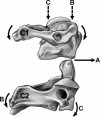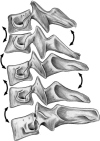Cervical spine functional anatomy and the biomechanics of injury due to compressive loading
- PMID: 16284634
- PMCID: PMC1250253
Cervical spine functional anatomy and the biomechanics of injury due to compressive loading
Abstract
Objective: To provide a foundation of knowledge concerning the functional anatomy, kinematic response, and mechanisms involved in axial-compression cervical spine injury as they relate to sport injury.
Data sources: We conducted literature searches through the Index Medicus, SPORT Discus, and PubMed databases and the Library of Congress from 1975-2003 using the key phrases cervical spine injury, biomechanics of cervical spine, football spinal injuries, kinematics of the cervical spine, and axial load.
Data synthesis: Research on normal kinematics and minor and major injury mechanisms to the cervical spine reveals the complex nature of movement in this segment. The movement into a single plane is not the product of equal and summative movement between and among all cervical vertebrae. Instead, individual vertebrae may experience a reversal of motion while traveling through a single plane of movement. Furthermore, vertebral movement in 1 plane often requires contributed movement in 1 or 2 other planes. Injury mechanisms are even more complex. The reaction of the cervical spine to an axial-load impact has been investigated using cadaver specimens and demonstrates a buckling effect. Impact location and head orientation affect the degree and level of resultant injury.
Conclusions/recommendations: As with any joint of the body, our understanding of the mechanisms of cervical spine injury will ultimately serve to reduce their occurrence and increase the likelihood of recognition and immediate care. However, the cervical spine is unique in its normal kinematics compared with joints of the extremities. Injury biomechanics in the cervical spine are complex, and much can still be learned about mechanisms of the cervical spine injury specific to sports.
Figures





References
-
- Kleiner DM, Almquist JL, Bailes J. Prehospital Care of the Spine-Injured Athlete: A Document From the Inter-Association Task Force for Appropriate Care of the Spine-Injured Athlete. et al. Dallas, TX: Inter-Association Task Force for Appropriate Care of the Spine-Injured Athlete; 2001.
-
- Scher AT. Rugby injuries of the spine and spinal cord. Clin Sports Med. 1987;6:87–99. - PubMed
-
- Torg JS, Guille JT, Jaffe S. Injuries to the cervical spine in American football players. J Bone Joint Surg Am. 2002;84:112–122. - PubMed
-
- Bruce DA, Schut L, Sutton LN. Brain and cervical spine injuries occurring during organized sports activities in children and adolescents. Prim Care. 1984;11:175–194. - PubMed
LinkOut - more resources
Full Text Sources
Medical
Research Materials
